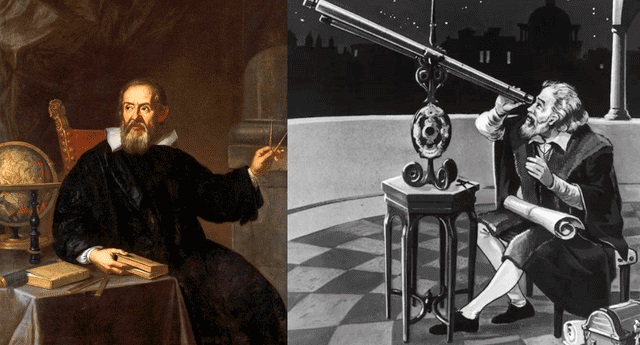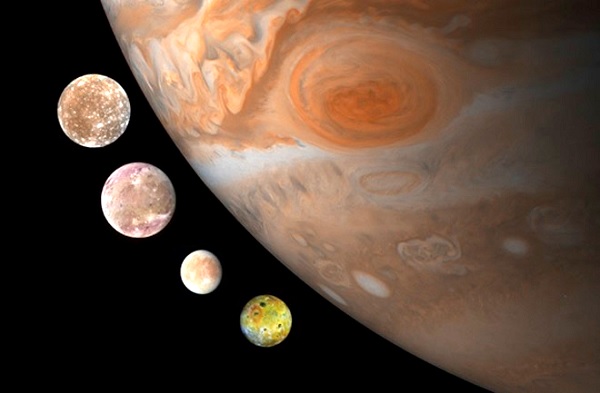Share
Galileo Galilei
Galileo was born in Pisa, Tuscany, on February 15, 1564, the eldest son of Vincenzo Galilei, a musician who made important contributions to the theory and practice of music. The family moved to Florence in the early 1570s, where the Galilei family had lived for generations.
As a teenager, Galileo attended school at the monastery of Vallombrosa, near Florence, and then, in 1581, he enrolled at the University of Pisa, where he was to study medicine. However, he fell in love with mathematics and decided to make mathematics and philosophy his profession, against his father's protests.
In 1585 Galileo left the university without having obtained a degree and for several years gave private mathematics lessons in Florence and Siena. During this period he designed a new form of hydrostatic balance for weighing small quantities. He also began his studies on movement, which he continued steadily for the next two decades.

In 1588 Galileo applied for the professorship of mathematics at the University of Bologna, but was unsuccessful. However, his reputation was growing and that same year he was asked to give two lectures at the Florentine Academy, a prestigious literary group, on the arrangement of the world in Dante's Inferno. He also found some ingenious theorems about the centers of gravity, which earned him recognition among mathematicians and the patronage of the noble Guidobaldo del Monte.
He obtained the chair of mathematics at the University of Pisa in 1589. There, Galileo demonstrated, throwing bodies of different weights from the top of the famous inclined platform. Torre, that the speed of fall of a heavy object is not proportional to its weight, as Aristotle had stated. In 1592 his contract was not renewed. His patrons, however, obtained him the professorship of mathematics at the University of Padua, where he taught from 1592 to 1610.
Galileo continued his research on motion, and in 1609 he had determined that the distance fallen by a body is proportional to the square of the elapsed time (the law of falling bodies) and that the trajectory of a projectile is a parabola, conclusions that They contradicted Aristotelian physics.
Heliocentric model of the universe
The telescope was invented at the end of the 16th century, in Holland. Galileo Galilei learned of the invention in 1609 and built one that was superior to the Dutch one for several reasons: It did not distort the objects. Galileo achieved magnifications of up to twenty times the size of the object while the first telescopes magnified it only three times and did not invert the image. Thanks to the improvement of the telescope, Galileo made great astronomical discoveries.

In August of that year he presented an instrument of eight powers to the Venetian Senate (Padua was in the Republic of Venice). He was rewarded with a lifetime position and a doubling of his salary.
Through the use of the telescope, he discovered the phases of Venus, the satellites revolving around Jupiter, the spots on the sun and the Milky Way. Galileo obtained enough data to dare to question the geocentric theory, which he proposed that the Earth was the center of the Universe. Through his observations he confirmed the heliocentric model of Nicholas Copernicus, and came to the conclusion that the Sun was the center of the galaxy and the planets revolved around the Sun.
Surface features of the Moon
From his observations, Galileo discovered that the moon was not smooth and uniform as previously believed. He concluded that the surface of the Moon was rough and uneven, made up of valleys, plains and mountains much like the surface of the Earth.
Spots on the Sun
For Galileo, the spots are either on the surface of the sun, as has been said, they are not other stars or solid bodies since they continually dissolve and are produced. There is a relationship between all the spots observed because they all have a common movement, hence it follows that the spots are in the solar body and it is this that moves them with it when it moves.
Sunspots were of great importance in the debate about the nature of the solar system. The Sun was shown to rotate and undergo changes, contrary to Aristotle's teaching. The details of its clear motion had no simple explanation except in the heliocentric system of Copernicus.
The phases of Venus
Venus was one of the astronomical problems for both the Ptolemaic and Copernican systems, since, according to both theories, its distance from the Earth varied greatly. But Galileo had another reason for observing Venus: he had reasoned that the Moon was an opaque body, shining only by reflecting the light of the Sun. If Venus were, similarly, an opaque body, it would have phases, like the Moon. So Galileo wanted to see if Venus had phases.

Galileo's discovery provides evidence that Venus goes through a complete series of phases and also naturally explains the correlation between the phases of Venus and its apparent size. Venus appears smaller when it is in full phase and larger when it is in crescent. Since Venus can be in full phase only when it is partly farthest from the Sun, which is when it is farthest from Earth, we would expect to see it smaller. Likewise, Venus can be in its crescent phase only when it is between the Earth and the Sun, when it is closest to the Earth, and therefore must appear larger during its crescent phase.
The 4 Satellites of Jupiter
The most curious thing, however, that Galileo was able to observe was that Jupiter was surrounded by moons and constituted a system similar to what should be the solar system. The astronomer first observed the Galilean satellites, named after him, on January 7, 1610, and at first thought they were three stars close to the planet, forming a line across it.

He was struck by the fact that these bodies seemed to have moved in another direction. On January 11 a fourth star appeared and, after a week of observation, he had seen that the four celestial bodies never left the vicinity of Jupiter and seemed to move with it, changing their position with respect to the other «stars» and the planet. Finally, Galileo determined that what he had been observing were not stars, but planetary satellites and published his conclusions in Siderius Nuncius, in March of the same year.
The trial of Galileo Galilei
Galileo published a small work that would be destined to revolutionize the scientific and philosophical panorama: «Sidereal Messenger.» It announced the discovery of mountains on the Moon and the existence of four satellites orbiting the planet Jupiter, a fact that broke one of the essential premises of geocentrism: that all celestial bodies revolved around our planet.
His revolutionary findings caught the attention of many scientists and, also, the rejection of most of the ecclesiastical authorities. To affirm that the Earth was not the center of the universe was an attack against one of the fundamental pillars of the Catholic Church. Censorship was not long in coming, and in 1616 the Holy Inquisition forbade Galileo to defend, disseminate, teach and support the heliocentric theory.

Ignoring the admonition, Galileo continued his fight in favor of heliocentrism with the publication of «Dialogues on the two highest systems of the world» in 1632. This time the Inquisition began to investigate this case as heresy. A year later, Galileo was tried in Rome for non-compliance with the censorship of 1616, treating it as a crime and threatening him with torture.
Galileo ended up being forced to deny the heliocentric theory and its findings. After rejecting his ideas, his sentence was reduced to house arrest that lasted from 1633 to 1638, the year in which he became blind. At that time The Holy Inquisition accepted his relocation to a place near the sea. He finally died on January 8, 1642, at the age of 77.
Galileo's contributions
Galileo Galilei firmly believed that everything that happened in nature could be explained by means of mathematical language. With his numbers and by developing the scientific method, the Italian scientist overturned many of the beliefs that were still widespread in the Renaissance mentality.
The telescope: Technically, he was not the one who invented the telescope from scratch, since there were already other similar objects with lenses that allowed to see larger objects. However, it was Galileo Galilei's ingenuity that made it possible to improve these devices, creating the first telescope as we know it today, an instrument that could magnify celestial bodies up to 30 times.
Heliocentric Theory: With his telescope, Galileo was able to observe the moon, the phases of Venus, sunspots and the four major moons of Jupiter. These discoveries revolutionized astronomy and confirmed Copernicus' heliocentric theory, which stated that the planets revolve around the sun. This discovery was a turning point in the history of astronomy, as it contradicted the prevailing geocentric theory of the time.
Galileo's laws of motion Galileo made important discoveries about the laws of motion, including the law of inertia. He demonstrated that objects do not need a force to keep them in motion, but maintain their state of motion unless an external force stops them. His experiments and observations are recorded in his work "Dialogues on the two highest systems of the world" published in 1632.
Galileo's law of free-fall: Galileo also studied the free fall of objects and proved that all objects fall with the same acceleration, regardless of their weight. His observations and experiments can be found in his work "Dialogues on the Two New Heavens" published in 1632.
The thermoscope: Galileo Galilei is also credited with creating the forerunner of the thermometer, called the thermoscope. It was a rather rudimentary tool to our eyes but complex for its time that served to measure temperature.
🥇 Find out more:
✅ The 4 Galilean satellites of Jupiter
✅ How big is the Moon? & How far is the Moon?
✅ Geocentric and Heliocentric models of the Universe

